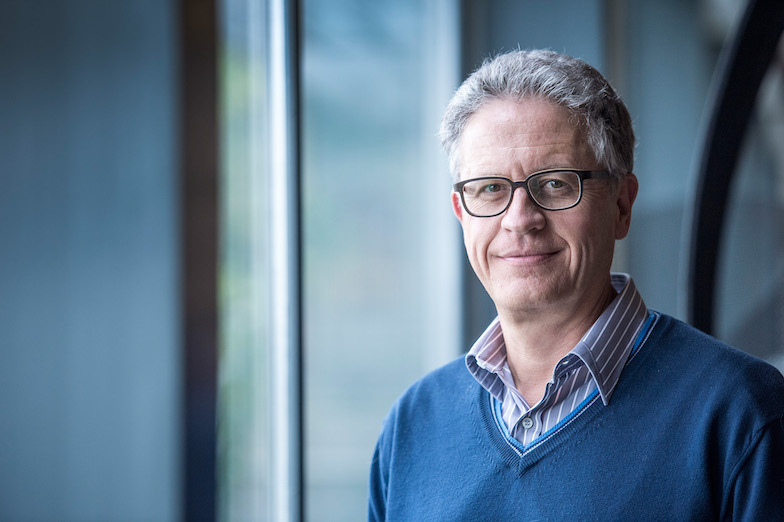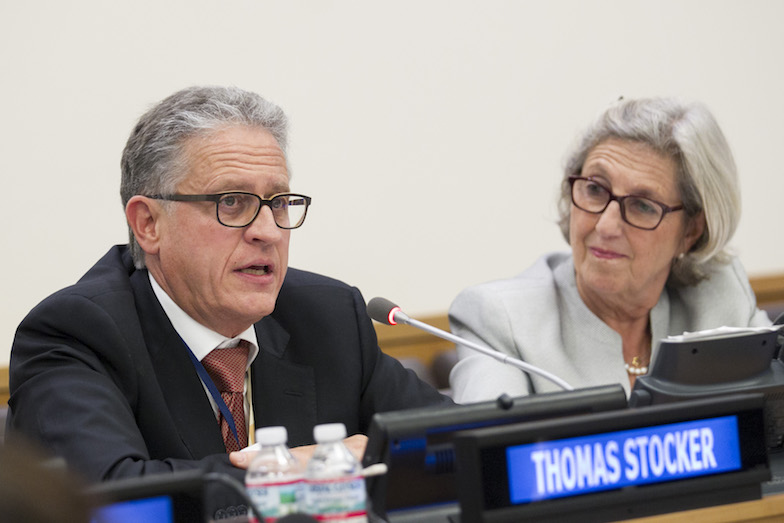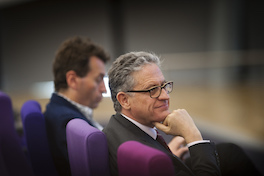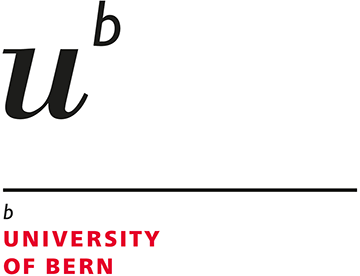A giant of climate science
In the beginning, there was a young student of physics in Switzerland, who discovered environmental physics in the 1980s. Today, Professor Thomas Stocker is widely considered a leading international expert in climate and environmental physics, having led pioneering work to prove scientifically that ongoing global warming is real.
Author: Faryal Mirza, International Relations Office

When Professor Stocker encountered environmental physics for the first time at the ETH Zurich, he was especially fascinated by investigating processes that he could actually touch and see. A life-long love was born. Stocker has now led the Climate and Environmental Physics division at the University of Bern’s Physics Institute for 25 years.
During his long stint with the United Nations Intergovernmental Panel on Climate Change (IPCC), Stocker was at the helm of a working group of scientists that produced the comprehensive assessment report Climate Change 2013: The Physical Science Basis. Once approved by governments, it became the scientific basis for the Paris Agreement of 2015 on climate change.
Thomas Stocker: The continuing discussion, in particular about the challenges and the threats that come from unabated climate change pose to us globally, has led to two effects.
One is that climate-guided legislation is beginning to emerge in many nations. Laws have been passed that try to satisfy the requirements first of the Kyoto Protocol and now the Paris Agreement on the nationally determined contributions to the reduction of greenhouse gas emissions. This is the very positive side.
Increased resistance and obstruction to really embark on this great energy transformation, which I usually liken to a fourth industrial revolution, that is decarbonization. This is about moving away from fossil-fuel technology that has served us very well for the last 150 years to new ways of harvesting energy and creating sustainable technologies.
This obstruction is particularly notable in the top leadership in the United States where very strong forces are still in power that try to hold on to old technologies and infrastructures. They are, in my opinion, missing out on one of the biggest opportunities in the 21st century.
How well developed are the new technologies that could replace the old?
They are very well developed but certainly not enough. Take the example of houses. With current technology, we are now able to build new houses that essentially no longer use energy and operate as small power plants. They take energy from the ground, harvest energy from solar panels and have excellent materials to reduce heat loss through walls and windows to a minimum. This technology has made tremendous progress.

Just over two years after the Paris accord came into being, is the scientific evidence forming its basis still valid today?
Absolutely more than ever. The main result of the IPCC work was that science could actually deliver factual evidence of an ongoing climatic change that manifests itself in the warming of the climate system and is unequivocal.
We stated that the human influence on the climate system is clear. Also, based on the scientific evidence and the knowledge about the carbon cycle,for example, and the reaction of the global climate system to the carbon dioxide in the atmosphere, limiting climate change requires sustained and substantial reductions in greenhouse gas emissions.
A short concise statement to that effect was agreed by all countries, which was at the heart of the later Paris Agreement for which we really laid the scientific basis. That makes all of us that were involved very proud.
Here is an anecdote from the IPCC days. During the entire time of writing the fifth assessment for the Panel from 2009 to 2013, there was a phase of a few years of a global mean temperature increase that was much lower than the same seen from 1950 to about 2010.
That led climate utopists to actually claim that global warming had stopped. They called that “the warming pause”. On the surface, it put into question the basic knowledge that we scientists had put to evidence in our report summary for policymakers. It required a very firm stand on our part to really get that through unscathed.
However, shortly afterwards in 2014, 2015 and 2016, Nature then gave us the three hottest years in the past 150 years of measurements on a global scale!
For me as a scientist, it was not only about compiling and directing this particular assessment into a final tangible product of a large report but also to write the summary for policymakers and then negotiate it through to consensus word by word. That was an extremely exciting process during which I learned a lot of skills that you would not be normally exposed to in the scientific arena.
It rests on two pillars. I should preface that by saying that I had the privilege to join an institute of world reputation. The work that we still carry out on the analysis of polar ice cores from Greenland and Antarctica was started in the late 1970s under my predecessor and his colleagues, who became very good friends. We carried on our research together.
The greenhouse-gas analysis of ice cores involves the extraction of these gases from tiny ice samples and then the measurement of the composition of the air that we extract from the ice.
This pillar is still very strong - we hold the world record in the reconstruction of carbon dioxide concentration, the most important greenhouse gas after water vapour, for the last 800,000 years. These measurements were done here, of which we are very proud.
A second pillar is climate modeling, my traditional area of activity. We develop climate models of so-called reduced complexity, which we can apply to very long timescales or run hundreds of thousands of times to produce the statistical evidence for climate change in the past and also in the future.
We are in the exploration phase of identifying where there could be an ideal location in Antarctica to find ice that is even older than 800,000 years.
We are aiming at a continuous climate history for the past 1.5 million years. This would be our dream - if we could realize it, it would make us very happy.
Not because we would then strive for another world record but because we would be able for the first time to enter a completely new climate epoch. An epoch in which the ice ages followed one another at a pace that was two and a half times faster than the pace of the last 800,000 years.
And since greenhouse gases are an important driver of the climate system, we are lacking some of the most elementary information. That is what we are after in this ice core.
13.08.2018
My international journey

Find out more about more about Thomas Stocker's path to Bern.
CV
Selected accolades
- 2006: Dr. Honoris Causa, University of Versailles
- 2009: Awarded Hans Oeschger Medal of the European Geosciences Union
- 2012: Dr. Honoris Causa, ETH Zürich
- 2016: Elected Fellow of the American Geophysical Union
- 2017: Swiss Science Prize Marcel Benoist
- Foreign Member of the Accademia Nazionale dei Lincei
- Foreign Honorary Member of the American Association of Arts and Sciences
